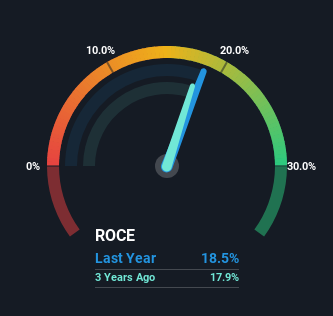- United States
- /
- Healthcare Services
- /
- NYSE:UNH
The Returns At UnitedHealth Group (NYSE:UNH) Aren't Growing

Finding a business that has the potential to grow substantially is not easy, but it is possible if we look at a few key financial metrics. Typically, we'll want to notice a trend of growing return on capital employed (ROCE) and alongside that, an expanding base of capital employed. This shows us that it's a compounding machine, able to continually reinvest its earnings back into the business and generate higher returns. That's why when we briefly looked at UnitedHealth Group's (NYSE:UNH) ROCE trend, we were pretty happy with what we saw.
What Is Return On Capital Employed (ROCE)?
If you haven't worked with ROCE before, it measures the 'return' (pre-tax profit) a company generates from capital employed in its business. The formula for this calculation on UnitedHealth Group is:
Return on Capital Employed = Earnings Before Interest and Tax (EBIT) ÷ (Total Assets - Current Liabilities)
0.19 = US$32b ÷ (US$274b - US$99b) (Based on the trailing twelve months to December 2023).
Therefore, UnitedHealth Group has an ROCE of 19%. In absolute terms, that's a satisfactory return, but compared to the Healthcare industry average of 11% it's much better.
Check out our latest analysis for UnitedHealth Group

In the above chart we have measured UnitedHealth Group's prior ROCE against its prior performance, but the future is arguably more important. If you'd like to see what analysts are forecasting going forward, you should check out our free analyst report for UnitedHealth Group .
What Can We Tell From UnitedHealth Group's ROCE Trend?
While the current returns on capital are decent, they haven't changed much. Over the past five years, ROCE has remained relatively flat at around 19% and the business has deployed 76% more capital into its operations. 19% is a pretty standard return, and it provides some comfort knowing that UnitedHealth Group has consistently earned this amount. Stable returns in this ballpark can be unexciting, but if they can be maintained over the long run, they often provide nice rewards to shareholders.
Our Take On UnitedHealth Group's ROCE
To sum it up, UnitedHealth Group has simply been reinvesting capital steadily, at those decent rates of return. And the stock has done incredibly well with a 112% return over the last five years, so long term investors are no doubt ecstatic with that result. So even though the stock might be more "expensive" than it was before, we think the strong fundamentals warrant this stock for further research.
One more thing to note, we've identified 1 warning sign with UnitedHealth Group and understanding this should be part of your investment process.
While UnitedHealth Group isn't earning the highest return, check out this free list of companies that are earning high returns on equity with solid balance sheets.
New: AI Stock Screener & Alerts
Our new AI Stock Screener scans the market every day to uncover opportunities.
• Dividend Powerhouses (3%+ Yield)
• Undervalued Small Caps with Insider Buying
• High growth Tech and AI Companies
Or build your own from over 50 metrics.
Have feedback on this article? Concerned about the content? Get in touch with us directly. Alternatively, email editorial-team (at) simplywallst.com.
This article by Simply Wall St is general in nature. We provide commentary based on historical data and analyst forecasts only using an unbiased methodology and our articles are not intended to be financial advice. It does not constitute a recommendation to buy or sell any stock, and does not take account of your objectives, or your financial situation. We aim to bring you long-term focused analysis driven by fundamental data. Note that our analysis may not factor in the latest price-sensitive company announcements or qualitative material. Simply Wall St has no position in any stocks mentioned.
About NYSE:UNH
UnitedHealth Group
Operates as a diversified health care company in the United States.
Established dividend payer and good value.
Similar Companies
Market Insights
Community Narratives




